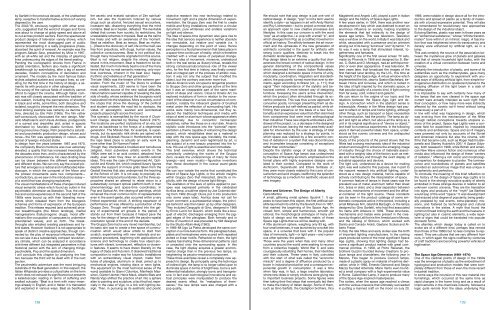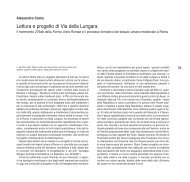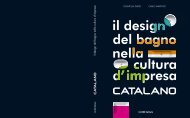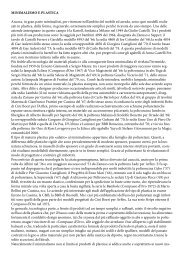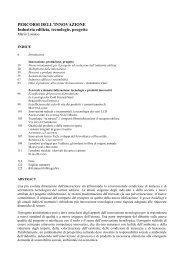SPACE AGE LIGHTS
SPACE AGE LIGHTS
SPACE AGE LIGHTS
Create successful ePaper yourself
Turn your PDF publications into a flip-book with our unique Google optimized e-Paper software.
y Sarfatti in the previous decade, of the unattached<br />
lamp, receptive to transformative actions (of varying<br />
degrees) by the user.<br />
The 2042/18, obviously together with other products,<br />
suggested that the world of images and forms<br />
was about to change at giddy speed and above all<br />
to cut across product sectors. Even the spectacular<br />
product designs of television variety shows, which<br />
represented the most disengaged part of public<br />
service broadcasting in a really progressive phase,<br />
absorbed the spirit of renewal. An example was the<br />
program Sabato Sera, presented by Mina in 1967,<br />
with an all-white set and the interplay of gleaming<br />
lines underscoring the edges of the tiered seating.<br />
Pending the iconographic shocks from France in<br />
spatial orientation, fashion also made a significant<br />
breakthrough by assimilating, after a lag of several<br />
decades, modern conceptions of decoration and<br />
ornament. The models by the most famous Italian<br />
stylists adopted austere and compact lines, so creating,<br />
for the first time in the history of design, a semantic<br />
tie with products in other categories.<br />
This survey of the various fields of creativity cannot<br />
afford to neglect the cinema. Although Italian comedy<br />
was still closely associated with the tradition of<br />
neo-realism, including the permanence of shooting<br />
in black and white, some films, both disruptive and<br />
isolated, sought to interpret the new dimension. The<br />
most striking example was certainly La decima vittima,<br />
directed by Elio Petri (1965). The film rather<br />
self-consciously showcased the new design. Marcello<br />
Mastroianni and Ursula Andress, protagonists<br />
of a surreal and dreamlike plot, acted in spaces<br />
dominated by futuristic plastic furniture. With a<br />
strong precursive charge, Petri presented a saturated<br />
and psychedelic production design, whose acid<br />
tones—the film was appropriately in colour—were<br />
typical of lysergic-induced states.<br />
In design from the years between 1967 and 1970,<br />
the complexity Branzi mentions was now extremely<br />
elevated, a quality that has increased inexorably in<br />
the decades since then, and is characterized by the<br />
phenomenon of interference. No clear dividing lines<br />
can be drawn between the different experiences<br />
and different styles. We can only say the overall picture<br />
that emerges is a radical and multifaceted kaleidoscope,<br />
in which the conquest of the Moon and<br />
the protest movements were two components—<br />
contradictory, as we saw in the introductory essay—<br />
of a world that was changing explosively.<br />
The visual manifestations of these changes induced<br />
visual semantic stress which found an outlet in the<br />
psychedelic dimension as liberation. True, the creative<br />
and social experiences of the second half of the<br />
1960s were bound up with their liberating movements<br />
which released them from the bourgeois<br />
schemes and forms of expression of the European<br />
tradition. This release required (and achieved) physical<br />
breakthroughs (the Moon landings), mental<br />
transgressions (hallucinogenic drugs), moral affirmations<br />
(the occupation of campuses to undermine<br />
preordained values), and so forth. The breakthroughs<br />
also entailed creating paradoxes and hybrid<br />
states. However I believe it is not appropriate to<br />
speak of distinct creative approaches, though connected<br />
by the play of reciprocal influences. Rather<br />
we can see it as a substantially compact revolutionary<br />
climate, which can be analyzed in accordance<br />
with three different but integrated parameters in that<br />
historical period with the aim of changing things:<br />
psychedelia, Pop and the spatial dimension.<br />
I will conclude this chapter by analyzing the first<br />
two because the third will be dealt with in the next<br />
section.<br />
The psychedelic adventure was the most intriguing<br />
substrate of the Beat generation. In this respect, the<br />
Italian Wikipedia provides a cultural take on the term<br />
which does not exhaust its significance but presents<br />
a kaleidoscopic reading in terms of suffering and<br />
exalted outcasts: “Beat is a term with many meanings<br />
already in English, and in Italian it is translated<br />
and explained in various ways. Beat as beatitude,<br />
the ascetic and ecstatic salvation of Zen spiritualism,<br />
but also the mysticism induced by various<br />
drugs such as alcohol, frenzied sexual encounters,<br />
incessant talk, dissecting everything that the mind<br />
contains. Beat as in beaten, defeated. The inevitable<br />
defeat that comes from society, its restrictions, the<br />
unassailable schemes it imposes. Beat as the call to<br />
live freely and with an awareness of the moment.<br />
Beat as rebellion. Beat as tempo. Beat as rhythm.<br />
[...] Beat is the discovery of self, life on the road, sex<br />
free from prejudices, with drugs, human values, the<br />
collective consciousness. Beat is not political but,<br />
though many movements originate from this source.<br />
Beat is not religion, despite the strong religious<br />
strand in this movement. Beat is freedom to be defeated.<br />
But much more likely beat is one of the many<br />
terms that has no real semantic meaning, only mystical<br />
overtones, inherent in the beat soul, happy,<br />
rhythmic and rebellious of that generation.”<br />
The late 1960s was the theatre of the extreme generation.<br />
From the music of The Doors to endless<br />
visual experiments, LSD seems to have been the<br />
most credible source of the new radical attitudes.<br />
Hallucinations seemed capable of revealing the dark<br />
side of reality, whose existence the bourgeois world<br />
had pushed into the shadows. More precisely, out of<br />
the utopia that drove the ideology of the political<br />
and student protests the road led to dystopia, the<br />
vistas of apocalyptic, severed and acontextual<br />
projects played right across the board.<br />
This scenario is exemplified by the movie A Clockwork<br />
Orange, directed by Stanley Kubrick (1971).<br />
The locations are perfect stylizations of an era, but<br />
serve as backdrops to the forays of a degenerate<br />
generation. The Moloko Bar, for example, is supertrendy,<br />
but its specialty milk drinks are spiked with<br />
drugs. And Skybreak House in Hertfordshire where<br />
the rape takes place is actually an early work by<br />
none other than Sir Norman Foster!<br />
Though they interpreted a troubled and tumultuous<br />
zeitgeist, most subversive artistic events in the<br />
1960s were set in an acid context, detached from<br />
reality, even when they drew on scientific-rational<br />
ideas. This was the case of Programmed Art, Optical<br />
Art and Kinetic Art, which created illusory figures<br />
despite the support of minute grids taken from the<br />
Gestalt theories that also underpinned the teaching<br />
at the School of Ulm. It is not easy to precisely establish<br />
their reciprocal boundaries, but the three approaches<br />
shared an attempt to relate vision to a<br />
substantially compact optical platform both in their<br />
phenomenology and space-time coordinates. In<br />
Pop and Optical Art, the viewing of paintings, which<br />
remained the most common form of representation<br />
even in the avant-garde, also occurred within a very<br />
limited experiential circuit. A striking expansion of<br />
performance art was offered by a production of the<br />
Gruppo Zero. Though well-integrated into the galaxy<br />
of experimental art groups in the period, it<br />
stands out from them because it helped pave the<br />
way for the design of lamps with the psycho-spatial<br />
orientation typical of the end of the decade.<br />
The Gruppo Zero had a very mixed membership, but<br />
its basic aim was to create a free space of communication<br />
which would allow artists to start from<br />
scratch, experimenting with new materials and expressive<br />
procedures, beginning with applications of<br />
science and technology to create true object-pictures<br />
with vibrant, luminescent, reflective or dynamic<br />
features. It seems to have drawn liberally on the<br />
legacy of Dada and Futurism. It dissolved traditional<br />
composition to make way for futuristic installations<br />
with an extraordinary visual impact, made from<br />
tubes of plexiglas, aluminum or steel, joined up to<br />
mechanical engines, rotating discs or neon lights.<br />
The equipment (in the most technical sense of the<br />
word) available to Gianni Colombo, Manfredo Massironi,<br />
Günter Uecher, Heinz Mack, Alberto Biasi and<br />
Nanda Vigo shifted the practice of art into a sphere<br />
alien to painting and sculpture, a fact that led, especially<br />
in the case of Vigo, to a link with lighting design.<br />
Then, in pursuing as its aesthetic and poetic<br />
objective research into new technology related to<br />
movement, light and a playful dimension of experimentation,<br />
the Gruppo Zero was the first to create<br />
mobile and flying installations centred on a circular<br />
dynamism, pure whiteness and endless variations<br />
on light and silence.<br />
The idea of space-time dynamism also gave rise to<br />
the idea that sensory experience is neither absolute<br />
nor immutable, but relative and variable (i.e. it<br />
changes depending on the point of view). Hence<br />
perception is a fluid phenomenon that takes place in<br />
a space-time continuum of reality, which is therefore<br />
credited with a virtual sense of perpetual change.<br />
The very idea of movement, moreover, understood<br />
both in the real sense as illusory/virtual, reveals the<br />
strong conscious/subconscious role of the viewer<br />
who, for the first time in history, was finally considered<br />
an integral part of the process of artistic creation:<br />
it was not only the subject that modified the<br />
object, but the contrary was even more true.<br />
Getulio Alviani’s work occupied a tangential position<br />
to Gruppo Zero and other groups active at the time<br />
but it was an inseparable part of the same maelstrom<br />
of ideas and visions. Close to Kinetic Art, he<br />
explored mutations of form in relation to the movement<br />
of the observer in a new circumstance of composition,<br />
notably the iridescent gleams of brushed<br />
metal under the reflection of surrounding light. His<br />
works were mainly two-dimensional, but they replaced<br />
the traditional techniques and media with<br />
strips of steel or aluminum whose appearance alters<br />
infinitesimally due to concentric microscopic<br />
scratches, rather like those on a vinyl disk. Alviani’s<br />
stylistic code introduces into the “pictorial” representation<br />
a theme capable of enhancing the design<br />
project, which rehabilitates steel as a material in<br />
step with the new space age. Inevitably, the metal,<br />
gleaming, dynamic and even legitimized by art, is<br />
the subject of a new beauty projected into the future.<br />
His use of light is essential and immediate.<br />
This brief overview, which shows the technical<br />
complexity underlying the works of the Gruppo<br />
Zero, reveals the underpinnings of many far more<br />
lysergic—and even mystic—figurative inventions<br />
than those developed in the coeval avant-garde<br />
currents.<br />
We can now isolate the works that constituted the<br />
strand of Space Age Lights, or the artistic insights<br />
within Gruppo Zero that interacted, directly or implicitly,<br />
with the design of some light fittings.<br />
The exaltation of the laws of optics applied to perspex<br />
was expressed primarily in the celebrated<br />
Acrilica lamp, a sublime object by Joe Colombo dating<br />
from 1962 (though Oluce put it into production<br />
only some years later). Acrilica does not call for<br />
much comment: a quintessential shape, the principle<br />
behind it was then taken up by other designers.<br />
They included Cespuglio di Gino, designed in 1968<br />
by Ennio Lucini for Guzzini, which looks like a bouquet<br />
of electric discharges emerging from the jagged<br />
edges of the plexiglass. Both formally and in<br />
terms of invention it was preceded by 584 designed<br />
by the Studio Albini-Helg (1963).<br />
In 1966–68 Ugo La Pietra developed the same conception<br />
in a more textural form. His plexiglass tubes,<br />
plates and hemispheres were scored with repeated<br />
dotted or linear motifs. Refracted on them, the light<br />
creates fascinating three-dimensional patterns cast<br />
or projected onto the surrounding space. In this<br />
case, the light display acquires a greater environmental<br />
charge than in the previous two lamps, so<br />
heightening its psycho-emotional component.<br />
These three examples reveal a completely new approach<br />
to design. By principally using the technique<br />
of indirect light, the lamp is no longer called upon to<br />
illuminate space in terms of brightness, but is a selfreferential<br />
installation, strongly iconic and transgressive.<br />
In fact even technological innovations and optical<br />
principles were manipulated to produce the<br />
desired scenic effect. As “metaphors of themselves,”<br />
the new lamps were also charged with a<br />
pop quality.<br />
We should note that pop design is just one vein of<br />
radical design. In design, “pop” is not a term used to<br />
identify a style—as happens in art with Andy Warhol<br />
and Roy Lichtenstein—but to project a mental style,<br />
an approach open to new creative processes and<br />
lifestyles. In this case our concern is with the word<br />
“pop” as an adjective, i.e. pop with a small “p”, and<br />
which diverges from Pop as a codified movement in<br />
official art history. The affinity between the art movement<br />
and the upheavals in the new generation of<br />
architects consisted in the quest for artifacts with<br />
strong iconic qualities, destined to break into the<br />
domestic landscapes of the day.<br />
Pop design takes to an extreme a quality that characterizes<br />
the broad context of radical design. In the<br />
general dismantling of the compositional values<br />
which descended from classic Italian Rationalism,<br />
which designed a domestic space in terms of unity,<br />
modularity, coordination, integration and standardization,<br />
the pop poetic turned more than ever to elements,<br />
again according to Branzi [cit., p. 111], that<br />
signal “their independence of the stylistic and behavioral<br />
context. A more tolerant way of designing<br />
furniture, foreseeing the user’s active intervention,<br />
which the product often stimulated through its eccentric<br />
presence. This was thus a new approach to<br />
consumer goods, no longer presenting them as definitive<br />
products but self-defined as partial, while affirming<br />
their presence on the basis of a new functionality<br />
and an expressive value that often stemmed<br />
from components that were more anthropological<br />
than industrial. These new objects embodied a withdrawal<br />
of the project, i.e. a decrease in the designed<br />
part of the house, leaving the main area freely available<br />
for intervention by the user. A strategy of total<br />
planning was replaced by a strategy by points, in<br />
which space was vitalized by a few eccentric centres<br />
of radiation in a system that was discontinuous<br />
and incomplete because consisting of exceptions<br />
rather than continuities.”<br />
Despite the stylistic range of radical design, the<br />
conception of Space Age lamps was underpinned<br />
by the idea of the lamp as totem, emphasized on the<br />
formal plane with highly expressive designs unrelated<br />
to their context. Compared to the work of<br />
Archizoom, Superstudio and Ettore Sottsass Jr.,<br />
they were more closely related to the icons of consumerism<br />
and acid images, reaffirming the splendor<br />
of technology as a medium for aesthetic values and<br />
new imagery.<br />
Home and Universe. The Design of Alterity<br />
Carlo Martino<br />
A small, glittering metal sphere: Sputnik 1. It appears<br />
to have been this object, the first artificial satellite<br />
launched into orbit by the Soviet Union in 1957,<br />
that marked the beginning of the Space Age. An<br />
closed form, simple and harmonious, smooth yet<br />
rational, the morphological archetype of many artifacts<br />
of design and the manifest matrix of those<br />
Space Age Lights that we will be dealing with.<br />
A little aluminum sphere, weighing only 83 kg, with<br />
four small antennas, it was launched by a rocket into<br />
space, in a universe that bore with it the popular<br />
idea of immensity, light—or light years—and numerous<br />
other spheres: the planets.<br />
Those were the years when Italy and many other<br />
countries around the world were seeking to recover<br />
from a collective tragedy, World War II, and were<br />
courageously rebuilding their homes, their identities<br />
and their cultures. These years in Italy coincided<br />
with the start of what was called the “economic<br />
miracle” and a degree of affluence produced by a<br />
boom in industrial production and a consequent exponential<br />
growth in consumption. It was a time<br />
when Italy was, in fact, a large creative laboratory<br />
where new ideas or simply intuitions were giving rise<br />
to important business projects. Some figures were<br />
then taking their first steps that eventually led them<br />
to make the history of Italian design. Some of them,<br />
such as Gino Sarfatti, the Castiglioni brothers, Vico<br />
Magistretti and Angelo Lelli, played a part in Italian<br />
design and the history of Space Age Lights.<br />
A few years earlier, in 1954, there was another new<br />
development in Italy which was destined to exert an<br />
enormous influence on society, helping crystallize<br />
the elements that led indirectly to the design of<br />
space age lamps. This was television. Television<br />
was a window on the world. Initially it was black and<br />
white, associated with a presence and an animism<br />
arising out of its being “luminous” and “dynamic.” In<br />
its way it was a lamp that stimulated interest, togetherness<br />
and fantasies.<br />
Significantly one of the first swivel screen TV sets,<br />
made by Phonola in 1956 and designed by S. Berizzi,<br />
C. Buttè and D. Montagni, had an anthropomorphic<br />
or even alien appearance. It was television, fifteen<br />
years later, that broadcast the images of the<br />
first manned lunar landing, by the U.S., this time at<br />
the height of the Space Age. A virtual window which<br />
implemented the link, dear to Gaston Bachelard, between<br />
Home and Universe, and which is rooted in<br />
the idea of light inspired by the domestic space, or<br />
that peculiar quality of a cosmic kind. A light coming<br />
from far away, cold, indirect and galactic.<br />
We can return to the origins of our topic and the<br />
relations between the Space Age, light and design.<br />
A connection which in the abstract sense is<br />
indissoluble. Already in the fifties design had paused<br />
to reflect on lamps and home lighting, although<br />
other things, such as transport or basic necessities<br />
for reconstruction, had the priority. The lamp as object<br />
and light as effect, but above all the lamp as a<br />
unit in its original significance of “device or object,”<br />
lent itself to numerous experiments. In the following<br />
years it derived powerful ideas from space, understood<br />
as the cosmic universe and the undisputed<br />
source of light.<br />
Study of the products of the period shows that the<br />
fifties had a strong mechanistic idea of the industrial<br />
product and sought to enhance the emerging image<br />
of industry through the choice of materials associated<br />
with a weighty idea of the factory such as metals<br />
and machinery and through the overt display of<br />
industrial apparatus and devices.<br />
The light unit, understood as a device for making<br />
light, was well suited to this purpose, due in part to<br />
the nascent research into artificial lighting, understood<br />
as a new design material, hence capable of<br />
actively contributing to the interpretation of space.<br />
A common feature of lamps in those years was the<br />
prevalent use of metal, aluminum rather than sheet<br />
iron, brass or steel, and a clear separation between<br />
structure, mechanisms of movement and the diffuser-container<br />
of the light source. These constants<br />
can be seen in the product catalogs of some emblematic<br />
companies active in the period, including a<br />
small Milanese firm, Gilardi & Barzaghi, or the lamps<br />
designed by Gino Sarfatti, who had first associated<br />
his name with Arteluce in 1939. These structures,<br />
mechanisms and metals were present in the creations<br />
by Angelo Lelli for his firm Arredoluce in Monza,<br />
and the catalog of Stilnovo, which worked with<br />
Danilo and Corrado Aroldi, Gaetano Scolari and Alberto<br />
Fraser.<br />
In Italy the late fifties and early sixties saw the birth<br />
of important lighting manufacturers. In the coming<br />
years produced some of the most significant Space<br />
Age Lights, showing that lighting design had become<br />
a significant product market with great commercial<br />
promise. In 1958, at Porto Recanati, the<br />
brothers Guzzini founded Harvey Creations to produce<br />
lamps and chandeliers; the following year in<br />
Merano, Flos began to produce Cocoon lamps,<br />
made of a plastic spray-on material of wartime derivation;<br />
while in 1960, Ernesto Gismondi and Sergio<br />
Mazza founded Artemide. Mario Vento even founded<br />
a small company with a high experimental value<br />
in Rome. Called New Lamp, it was to produce many<br />
of the Space Age-inspired masterpieces.<br />
The sixties, when the space age reached a climax<br />
with the various missions that ultimately succeeded<br />
in putting a manned craft on the moon on July 20,<br />
1969, were notable in design above all for the introduction<br />
and spread of plastic as a family of materials<br />
with a broad expressive potential. They will also<br />
be remembered for revolutionary new approaches<br />
to the design of the industrial object.<br />
Echoing Barthes, plastic was seen in those years as<br />
an “alchemical substance,” whose “infinite transformation”<br />
bore within it an intrinsic magic. A fascination<br />
that was heightened when its translucency and<br />
density were enhanced by artificial light, as in a<br />
lamp.<br />
This was certainly the source of the association between<br />
the mysterious glow of planets and galaxies<br />
and that of simple household light bulbs, with the<br />
creation of a virtual connection between home and<br />
universe.<br />
Certainly the introduction of plastic, and some of its<br />
subfamilies such as the methacrylates, gave many<br />
designers an opportunity to experiment with unusual<br />
ways of diffusing artificial light, from simple homogeneous<br />
distribution on opalescent planes to the<br />
amazing diffusion of the light beam in a slab of<br />
methacrylate.<br />
It is impossible to say with certainty how many of<br />
the lamps that are now classed in the space age<br />
current were actually intended as such right from<br />
their conception, or how many more were indirectly<br />
affected by the cosmic sci-fi trend without being<br />
consciously a part of it.<br />
In line with what was happening in design, which<br />
was evolving from the mechanicism of the fifties<br />
through radical conceptions towards utopians visions<br />
of the project, Space Age Lights were a concrete<br />
field for experiment, inspired by impossible<br />
contexts and ambiances. Space and sci-fi imagery<br />
were powered not only by accounts of the Soviet<br />
and American missions but also the cinema, with<br />
films that became cults, such as Roger Vadim’s Barbarella<br />
and Stanley Kubrick’s 2001 A Space Odyssey,<br />
both released in 1968, while British and American<br />
New Wave science fiction and numerous other<br />
media also influenced the design of these “centers<br />
of radiation,” offering a rich iconic and morphological<br />
repertory for designers to plunder. The luminescence<br />
and roundedness of planets and satellites<br />
provided an autonomous image that was unique in<br />
its sphericity and perfection.<br />
To conclude, the meaning of this brief reflection on<br />
the history of the design of Space Age Lights is to<br />
be found in the strongly evocative quality of alterity<br />
embodied in these strange devices in relation to an<br />
unknown cosmic universe. They are the translation<br />
into signs and products of the “myth” (as Barthes<br />
would say) of the word “space.” It was development<br />
that enjoyed a fair degree of popularity, being gradually<br />
prepared by real events, extra-planetary missions,<br />
and fostered by technological and cultural<br />
innovations in the sixties. A myth that found the<br />
common thread linking the earth and the heavens in<br />
lighting but also in cosmic elements, a wide repertoire<br />
of signs that could be translated into popular<br />
domestic forms.<br />
The alterities which design today is called on to<br />
evoke are of a different kind, perhaps less remote<br />
than those of the 1960s but no less complex to represent.<br />
They are cultures that are very different from<br />
ours, in which again the signs codified by centuries<br />
of craft traditions are becoming powerful vehicles of<br />
legitimation.<br />
The Space Age Dimension (1961-1974)<br />
One of the cardinal points of design in the 1960s<br />
was the emergence of plastic as the embodiment of<br />
typological and production models that were completely<br />
different from those of even the more recent<br />
industrial tradition.<br />
In some ways the incursion of this new material into<br />
furnishings, which occurred at the same time as<br />
rapid changes in the home living and as a result of<br />
improvements in the chemicals industry, followed a<br />
logic quite remote from the ideas underlying Pop<br />
138 139


